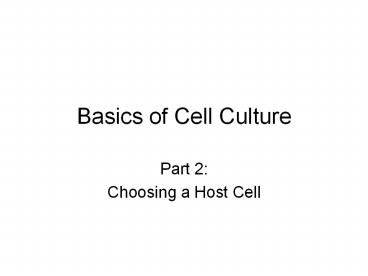Basics of Cell Culture - PowerPoint PPT Presentation
1 / 20
Title:
Basics of Cell Culture
Description:
Non-tumorigenic 'Typical behaviors' Transformed cells. May not require surface ... May be tumorigenic. Loss of 'typical behaviors' 16. 16. Mammalian Cell Culture ... – PowerPoint PPT presentation
Number of Views:1225
Avg rating:3.0/5.0
Title: Basics of Cell Culture
1
Basics of Cell Culture
- Part 2
- Choosing a Host Cell
2
Overview
- Kinds of cells used in industry
- Advantages
- Disadvantages
- Large scale cell growth issues
- Sterility
- Cleanliness
- Consistency
3
Cells Used in Bioprocessing
- Different options
- Choice based on many variables
- No perfect single choice
- Bacterial cells
- Yeast cells
- Insect cells
- Mammalian cells
4
Industrial Bacteria
- Gram negative bacteria
- E. coli
- Produce lipopolysaccharide (an endotoxin)
- Gram positive bacteria
- B. subtillus
- No endotoxins
5
Industrial Yeast
- Eukaryotic
- S. cerevisiae
- Brewers and bakers yeast
- Alcohol dehydrogenase system
- P. pastoris
- Methanol producer
- High level of protein synthesis
- High cell density
6
Microbial Advantages
- Simple media
- Fast growth rates
- Sturdy cells
- Cell walls outside plasma membrane
- Faster mixing possible
- Faster sparging rate
- Long history of large-scale use
7
Microbial Disadvantages
- Potentially infectious
- Endotoxin (with some cells)
- Sturdy cells
- Harder to break open
- Harder to purify internal protein
- Simpler post-translational modifications
- Bacterial inclusion bodies
8
Protein Modifications
- Functional groups added to proteins
- After translation is done
- Increase functionality of protein
- Membrane association
- Extra-cellular protection
- Activity regulation
- Limited in bacteria, extensive in mammals
9
Inclusion Bodies
- Bacterial defense
- Normally have balanced protein profile
- Too much of one protein is bad
- Protection by isolation
- Excess protein stored in aggregation
- Too much for cell to process
- Active protein may be recoverable
10
Renaturing Inclusion Bodies
- Lyse cells
- Separate soluble from particulate
- Add strong protein denaturant
- Aggregate held by hydrophobic interactions
- Denaturant breaks hydrophobic bonds
- Renature protein into proper conformation
- Optimization can be difficult
11
Mammalian Cells
- Various species used
- Monkey
- Rat
- Mouse
- Hamster
- Various cell types used
- Each originally from a single animal
12
Primary Cell Culture
- Obtain source of cells (organ, tissue, etc.)
- Dissociate cells
- Scissors
- Digestive enzymes
- Grow on treated plates
- Isolate cell of interest
- Fastest growing cells?
- Selective conditions for cell type?
- Divide cells as they fill up surface of plates
13
Mammalian Cells- Live or Die?
14
Transformation
- Different from bacterial transformation
- De-differentiation
- Anchorage dependence may be lost
- Lower serum requirement for growth
- Loss of normal behaviors or functions
- Immortality
- Induced by some chemicals or viruses
- Spontaneous in some cell types
15
Cell Characteristics
- Normal mammalian
- Surface attachment
- Contact inhibition
- Require growth stimuli
- Mortal
- Non-tumorigenic
- Typical behaviors
- Transformed cells
- May not require surface
- Overgrow monolayer
- Independent of stimuli
- Immortal
- May be tumorigenic
- Loss of typical behaviors
16
Mammalian Cell Culture
- Mammalian cells used industrially are transformed
- Continuous cell lines
- Immortal
- Usually suspension culture
- Chinese Hamster Ovary (CHO)
- Surface or suspension growth
- Versatile synthetic machinery
- Intracellular or extracellular proteins
17
Mammalian Disadvantages
- Viruses
- Mycoplasma
- Slow growth rate
- Serum costs
- Risk of genetic instability
18
Mammalian Advantages
- Good at making mammalian proteins
- Secretory signals
- Post-translational modifications
19
Fermentor vs. Bioreactor
- Microbial cells grown in fermentor
- Original stirred tank reactor (STR)
- Generally use rapid stirring
- Mammalian cells grown in bioreactor
- Same general structure
- Gentler mixing since cells more fragile
- Size range more limited
20
Review
- Many cell options are available
- Choose on cost and usability
- Media/growth expense
- Ability to make protein properly
- Balance advantages vs. disadvantages
- Bottom line is useful product
- Minimize cost but make product































